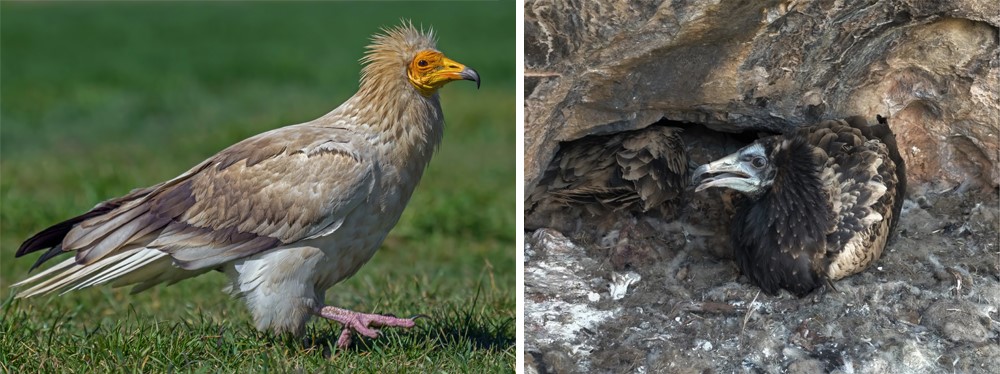Egyptian vultures raise more males in the Canary Islands than in the Iberian Peninsula
Small changes in the sex ratio in threatened species may cause significant alterations in their populations.

Researchers from the Spanish National Research Council (CSIC) has found that pairs of Egyptian vultures, Neophron percnopterus, raise more male chicks than females in the Canary Islands than in the Peninsula. This variation may be due to the higher cost of rearing female offspring due to the larger size of individuals, and the resources available in the easter Canary islands, where they breed, may be scarcer because of their aridity. The relevance of this research, carried out during almost three decades, lies in the fact that variations on offspring sex ratio of threatened populations, as those of Egyptian vultures, can generate dangerous alterations that can compromise their viability.
Egyptian vultures are a small vulture species that breeds in a large part of Spain and winters in Africa. “Vultures are essential for natural environment and our own society, since they are responsible for removing animal carcasses from the field and, with them, a multitude of pathogens and associated diseases, including emerging diseases”, says Guillermo Gómez López, a researcher in the Spanish National Museum of Natural Sciences and first author of the study. The aim of this study, published in the journal Ecology and Evolution, has been to determine which is the sex ratio in Egyptian vulture nestlings and what factors may influence this ratio. They are important data for the conservation of the species, which is listed as endangered worldwide by The International Union for Conservation of Nature (IUCN).
“After determine the sex of more than 1600 Egyptian vulture nestlings, monitored in the Iberian Peninsula, Balear and Canary Islands during almost 30 years, we found that there is a higher proportion of female nestlings in the Peninsula (53%), and especially, a higher amount of male nestlings in the Canary Islands (55%)”, points out Gómez López. “This difference could be due to the particular conditions of the breeding areas in the eastern Canary Islands, where there is a significant aridity and food scarcity, and also to the proportion of immatures breeding in the different populations”, continues the researcher.
The Doñana Biological Station is another CSIC institute participating in the scientific publication. The EBD mantains two Egyptian vulture population monitoring programs, one in the Ebro valley, initiated more than 30 years ago, and another one in Canary Islands, almost 25 years old. These long-term monitoring programs, unique in Spain and Europe, provide data allowing to address key questions on the ecology and conservation of these endangered species, such as those investigated in this study.
“The fact that there is no a similar proportion of females and males in a species that form monogamous pairs may cause a decrease in the viablity of their populations in the long-term, something that has already been demonstrated for other vertebrates with unbalanced sex ratio”, explains José Antonio Donázar, a Professor of Research at the Doñana Biological Station. “This could be aggravated due to maladaptative behaviours such as, for instance, the existence of breeding units based on trios rather than pairs”.
It is only a hypothesis, but it is possible that these birds raise more male nestlings in the Canary Islands because they need less food, since they are smaller than the females. “It is essential to keep conducting studies like this one to better understand the ecology of populations that, such as the Canary Egyptian vulture, are isolated. Small changes in the sex ratio of threatened species that raise only one or two chicks per year may cause large alterations in a whole population”, concludes Gómez López.
Reference:
Guillermo Gómez-López, Ana Sanz-Aguilar, Martina Carrete, Eneko Arrondo, José Ramón Benítez, Olga Ceballos, Ainara Cortés-Avizanda, Félix de Pablo, José Antonio Donázar, Óscar Frías, Laura Gangoso, Marina García-Alfonso, José Luis González, Juan Manuel Grande, David Serrano, José Luis Tella, Guillermo Blanco. Insularity determines nestling sex ratio variation in Egyptian vulture populations. Ecology and Evolution DOI: https://doi.org/10.1002/ece3.10371